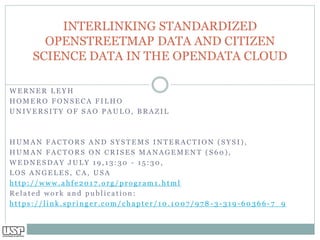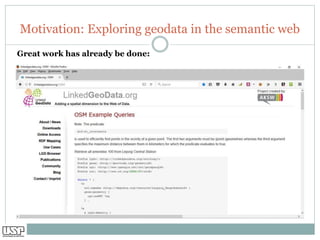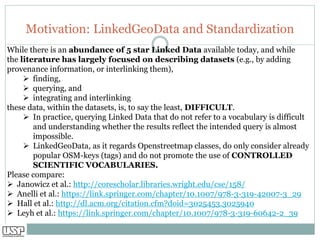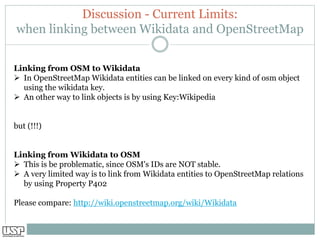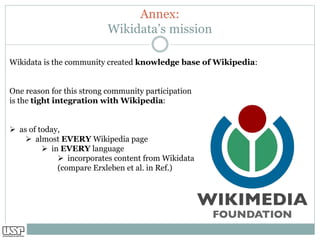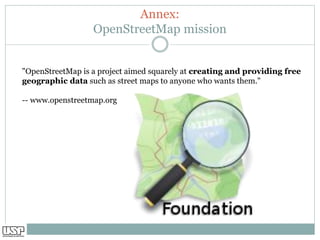Interlinking Standardized OpenStreetMap Data and Citizen Science Data in the OpenData Cloud
- 1. W E R N E R L E Y H H O M E R O F O N S E C A F I L H O U N I V E R S I T Y O F S A O P A U L O , B R A Z I L H U M A N F A C T O R S A N D S Y S T E M S I N T E R A C T I O N ( S Y S I ) , H U M A N F A C T O R S O N C R I S E S M A N A G E M E N T ( S 6 0 ) , W E D N E S D A Y J U L Y 1 9 , 1 3 : 3 0 - 1 5 : 3 0 , L O S A N G E L E S , C A , U S A h t t p : / / w w w . a h f e 2 0 1 7 . o r g / p r o g r a m 1 . h t m l R e l a t e d w o r k a n d p u b l i c a t i o n : h t t p s : / / l i n k . s p r i n g e r . c o m / c h a p t e r / 1 0 . 1 0 0 7 / 9 7 8 - 3 - 3 1 9 - 6 0 3 6 6 - 7 _ 9 INTERLINKING STANDARDIZED OPENSTREETMAP DATA AND CITIZEN SCIENCE DATA IN THE OPENDATA CLOUD
- 2. Overview: The great picture Summarizing Our Contributions To INTERLINKING STANDARDIZED OPENSTREETMAP DATA AND CITIZEN SCIENCE DATA In the OPENDATA CLOUD
- 3. Overview: The great picture – What, Why, How, When and Where What The aim of this work is to explore the OPPORTUNITIES offered by SEMANTIC STANDARDIZATION to interlink primary spatial data from OPENSTREETMAP(OSM) with the LINKEDOPENDATA Cloud(LOD) Why One way to think about ENVIRONMENTAL DATA is as a NETWORK OF CONNECTED ENTITIES, such as physical features, events, publications, people, species, sequences, images, and data collections that form the ENVIRONMENTAL KNOWLEDGE GRAPH. Many questions in environmental informatics can be framed as paths in this graph. How WIKIDATA is a world readable and writable COMMUNITY-DRIVEN KNOWLEDGE BASE. It offers the opportunity to collaboratively construct an open access knowledge graph that spans biology, medicine, and all other domains of knowledge. IN THIS STUDY we discuss the OPPORTUNITIES AND CHALLENGES provided by exploring Wikidata as a CENTRAL INTEGRATION FACILITY by interlink it with OSM, a COMMUNITY DRIVEN SPATIAL DATA COLLECTION. When 2017 Where International
- 4. Overview: Outline and Content Part 0: Overview: The great picture What, Why, How, When and Where Part 1: Motivation: Exploring geodata in the semantic web Part 2: Introduction: Context and Former work Part 3: Main Challenges Amount of data + producers; Integration of data; Language in common for Semantic Interoperability; Part 4: Main Contributions Wikidata: Opportunities & challenges for Citizen Science; Part 4: Applied approaches The “Five stars of Linked Data Vocabulary Use” Wikidata´s Sparql Query Service Part 5: Results Interlinking Wikidata and Openstreetmap using SPARQL-queries: Try it !!! OverPass-based Text-Mining of OpenStreetMap data Part 6: Discussions, Current Limits and Conclusions Citation needed!, Text-Mining Annex
- 5. Motivation: Exploring geodata in the semantic web Great work has already be done:
- 6. Motivation: LinkedGeoData Strengths ➢ LinkedGeoData uses the comprehensive OpenStreetMap spatial data collection ➢ to create a large spatial knowledge base. ➢ It consists of more than 3 billion nodes and 300 million ways and the resulting RDF data comprises approximately 20 billion triples. ➢ The data is available according to the LINKED DATA PRINCIPLES and INTERLINKED with WIKIDATA, DBPEDIA, WIKIMAPIA, GEONAMES, NATURAL EARTH ➢ Please compare: http://linkedgeodata.org/About The LINKEDGEODATA (LGD) data set is a work of the Agile Knowledge Engineering and Semantic Web (AKSW) research group at the University of Leipzig, a group mostly known for DBPEDIA, that uses the GeoSPARQL vocabulary to represent OpenStreetMap data.
- 7. Motivation: LinkedGeoData Limitations LinkedGeoData aims at TRIPLIFYING OPENSTREETMAP DUMPS EVERY SIX MONTHS by map-ping OSM tags with reference to a publicly available ontology. This is a very useful resource because it makes available classes that map keys and tags used in Open Street Map nodes, but: ➢ LinkedGeoData approach cannot be used for all those scenarios where TIMELINESS AND FRESHNESS OF INFORMATION is a must have. e.g. in DISASTER RECOVERY where information needs to be available as soon as possible. ➢ Although very useful and structured, a STATIC ONTOLOGY as the one modelled within the LinkedGeoData project, cannot follow continuous data variations due to USERS FREEDOM IN INSERTING NEW TAGS AND VALUES. Please compare: Anelli et al.: https://link.springer.com/chapter/10.1007/978-3-319-42007-3_29
- 8. Motivation: LinkedGeoData and Standardization While there is an abundance of 5 star Linked Data available today, and while the literature has largely focused on describing datasets (e.g., by adding provenance information, or interlinking them), ➢ finding, ➢ querying, and ➢ integrating and interlinking these data, within the datasets, is, to say the least, DIFFICULT. ➢ In practice, querying Linked Data that do not refer to a vocabulary is difficult and understanding whether the results reflect the intended query is almost impossible. ➢ LinkedGeoData, as it regards Openstreetmap classes, do only consider already popular OSM-keys (tags) and do not promote the use of CONTROLLED SCIENTIFIC VOCABULARIES. Please compare: ➢ Janowicz et al.: http://corescholar.libraries.wright.edu/cse/158/ ➢ Anelli et al.: https://link.springer.com/chapter/10.1007/978-3-319-42007-3_29 ➢ Hall et al.: http://dl.acm.org/citation.cfm?doid=3025453.3025940 ➢ Leyh et al.: https://link.springer.com/chapter/10.1007/978-3-319-60642-2_39
- 9. Introduction: Context and Former work IN THE ANNEX WE ARE INTRODUCING ➢ Tim Berners Lee 5 star-schema of Linked Open Data ➢ The Five Stars of Linked Data Vocabulary Use ➢ Linked Data: RDF Data Model & SPARQL ➢ Wikipedia, Wikidata and OpenStreetMap ➢ Wikidata: Establishing computable trust PLEASE CONSIDER ALSO OUR MAIN REFERENCES: Good et al. http://icbo.cgrb.oregonstate.edu/node/331 Rafes and Germain https://hal.inria.fr/hal-01168496v1 Janowicz et al. http://corescholar.libraries.wright.edu/cse/158/ Erxleben et al. www.gtn-h.info/wp-content/uploads/2015/10/GTNH-7_Report.pdf Hall et al. http://dl.acm.org/citation.cfm?doid=3025453.3025940 Anelli et al. https://link.springer.com/chapter/10.1007/978-3-319-42007-3_29 Berners-Lee https://www.w3.org/DesignIssues/LinkedData.html Senaratne et al. http://www.tandfonline.com/doi/full/10.1080/13658816.2016.1189556
- 10. Main Challenges: Amount of data + producers, Integration of data, Semantic Interoperability I Amount of data + producers; E.g.: According to a new study published by a top industry trade group, Americans used nearly 10 billion gigabytes of mobile data last year: That's more than double they used the year before. https://www.washingtonpost.com/news/the- switch/wp/2016/05/23/americans-are-using-a-whopping-amount-of- data-these-days/ And: Data consumers are increasingly becoming data producers II Integration of this data: III A Language in common for Semantic Interoperability
- 11. Main Contributions: Opportunities & challenges of Wikidata + Five Stars of Linked Data Vocabulary Use … … for Citizen Science: Good et al. outline questions on OPPORTUNITIES AND CHALLENGES that WIKIDATA provides to the broad BIO-CURATION COMMUNITY: ➢ This questions will be applied and discussed in our present work to improve INTEROPERABILITY between OFFICIAL and COMMUNITY based KNOWLEDGE, by reusing of controlled vocabularies. ➢ The present work can be regarded as a CITIZEN SCIENCE - ORIENTED response to the FIVE STARS OF LINKED DATA VOCABULARY USE system put forward by Janowicz et al. (references).
- 12. Applied approaches: Summary ➢ (MA1) The FIVE STARS OF LINKED DATA VOCABULARY USE. ➢ (MA2) Literature Review. ➢ (MA3) WIKIDATA´S SPARQL QUERY SERVICE (WDQS). ➢ (MA4) Mapping against OPPORTUNITIES and CHALLENGES of WIKIDATA. ➢ (MA5) We explored the so-called TALK-PAGES in COMMUNITY-WIKI.
- 13. Applied approaches: Ontologies to make your data more usable
- 14. Results - Wikidata-based integration: Information gathering (queries): Try it !!! !!! Interlinking Wikidata and Openstreetmap World-Map of hospitals (http://tinyurl.co m/k46vxg2): Try it !!! !!!
- 15. Results - Wikidata-based integration: Information gathering (queries): Try it !!! !!! Interlinking Wikidata and Openstreetmap – World-Map of hospitals (http://tinyurl.com/k46vxg2): Try it !!! !!!
- 16. Discussion - Current Limits: Wikidata trustworthiness: Citation needed! A KEY FEATURE OF THE WIKIDATA is the capacity to provide PROVENANCE FOR ITS CLAIMS (the triples that compose the knowledge graph) through references. ➢ Each claim can be supported by any number of REFERENCES TO SUPPORTING SOURCES of information. ➢ Unfortunately, currently MANY CLAIMS WERE NOT ASSIGNED REFERENCES. Please compare: Good et al.: http://icbo.cgrb.oregonstate.edu/node/331 Katie Mika: https://library.mcz.harvard.edu/blog/role-librarians-wikidata-and%C2%A0wikicite
- 17. Discussion - Current Limits: when linking between Wikidata and OpenStreetMap Linking from OSM to Wikidata ➢ In OpenStreetMap Wikidata entities can be linked on every kind of osm object using the wikidata key. ➢ An other way to link objects is by using Key:Wikipedia but (!!!) Linking from Wikidata to OSM ➢ This is be problematic, since OSM's IDs are NOT stable. ➢ A very limited way is to link from Wikidata entities to OpenStreetMap relations by using Property P402 Please compare: http://wiki.openstreetmap.org/wiki/Wikidata
- 18. Discussion - Complementary approach: OverPass-based Text-Mining of OpenStreetMap data (Geographic) Datasets are typically integrated (“joined”) exploring ➢ Descriptive Context Dimensions ➢ “who, what, where, when, why, and how” provided by the attributes of (geographic) features. In the case of OpenStreetMap this can be done by ➢ Exploring “KEY” and “VALUE” pairs provided by OSM-TAG as attributes to describe “OSM-node” representing for example Points of Interests (POIs) ➢ A particular powerful solution when applied with protocols based on internationally accepted metadata standards
- 19. Conclusions: Summary This study shows how “standardized” WIKIDATA and OPENSTREETMAP “interlinking” can lead to LOD-integration, particularly when the capacity of WIKIDATA is explored as a POWERFUL INTEGRATOR THROUGHOUT the Semantic Web. The study provides a description of conceptual considerations as well as the WIKIDATA-BASED INTEGRATION of “PRIMARY COMMUNITY DATA (e.g. OpenstreetMap)” with AUTHORITATIVE LINKED-OPEN-DATA (e.g. WikiData)”
- 20. Werner Leyh h t t p s : / / w i k i . o s g e o . o r g / w i k i / U s e r : W e r n e r L e y h Grupo de Pesquisa CNPq/USP I N F R A E S T R U T U R A D E D A D O S E S P A C I A I S ( G E P I D E ) h t t p : / / d g p . c n p q . b r / b u s c a o p e r a c i o n a l / d e t a l h e g r u p o . j s p ? g r u p o = 0 0 6 7 1 0 7 H R Y 8 K T 0 Questions ? Interested in linking Wikidata, Openstreetmap and scientific Datasets? Join us !
- 21. Annex
- 22. Annex: Tim Berners Lee 5 star-schema of Linked Open Data ☆ Data is available on the Web, in whatever format. ☆☆ Available as machine-readable structured data, (i.e., not a scanned image). ☆☆☆ Available in a non-proprietary format, (i.e, CSV, not Microsoft Excel). ☆☆☆☆ Published using open standards from the W3C (RDF and SPARQL). ☆☆☆☆☆ All of the above and links to other Linked Open Data.
- 23. Annex: The Five Stars of Linked Data Vocabulary Use The Five Stars of Linked Data Vocabulary Use: Interestingly, the original ‘Tim Berners Lee 5 star-schema” does not make any assumptions about the use of vocabularies. In practice, however, querying Linked Data that do not refer to a vocabulary is difficult and ➢ understanding whether the results reflect the intended query is almost impossible. See Five Stars of Linked Data Vocabulary Use http://semantic-web-journal.net/content/ five-stars-linked-data-vocabulary-use
- 24. Annex: Linked Data: RDF Data Model & SPARQL RDF breaks every piece of information down in triples: ➢ Subject – a resource, which is identified with a URI. ➢ Predicate – a URI-identified reused specification of the relationship. ➢ Object – a resource or literal to which the subject is related. <Bob> <is a> <person>. <Bob> <is interested in> <the Mona Lisa>. <the Mona Lisa> <was created by> <Leonardo da Vinci> Source: https://www.w3.org/TR/2014/NOTE-rdf11- primer-20140624/#section-triple
- 26. Annex: Wikipedia’s scale ➢ 30 million articles ➢ 286 languages ➢ 2 billion edits ➢ 8000 views per second ➢ 500 million monthly visitors ➢ 5th most popular website ➢ 2000 x larger than Britannica
- 27. Annex: Wikidata’s mission Wikidata is the community created knowledge base of Wikipedia: One reason for this strong community participation is the tight integration with Wikipedia: ➢ as of today, ➢ almost EVERY Wikipedia page ➢ in EVERY language ➢ incorporates content from Wikidata (compare Erxleben et al. in Ref.)
- 28. Annex: WikiData characteristics ➢ An item for any notable subject ➢ “Claims” (or “statements”) about each item, using clearly-defined “properties” ➢ Properties may have “qualifiers” ➢ Every item is an “instance of” or “subclass of” another ➢ Claims show relationships between items ➢ Multi-lingual labels and descriptions ➢ Claims may include identifiers
- 30. Annex: OpenStreetMap mission "OpenStreetMap is a project aimed squarely at creating and providing free geographic data such as street maps to anyone who wants them." -- www.openstreetmap.org
- 31. Annex: OpenStreetMap characteristics OpenStreetMap Basic Definitions: ➢ It’s a very large database of XML data ➢ Each feature is of a certain basic type, and is defined by Tags (key value pairs) ➢ Basic types: Nodes (points), Ways (lines), Areas (polygons), Relations (groups) ➢ Tags: (domain.)key (concept) = value (instance)
